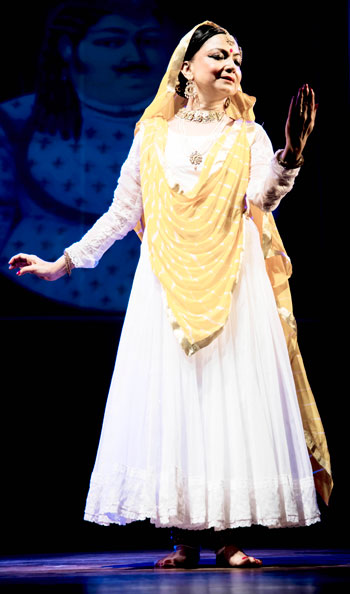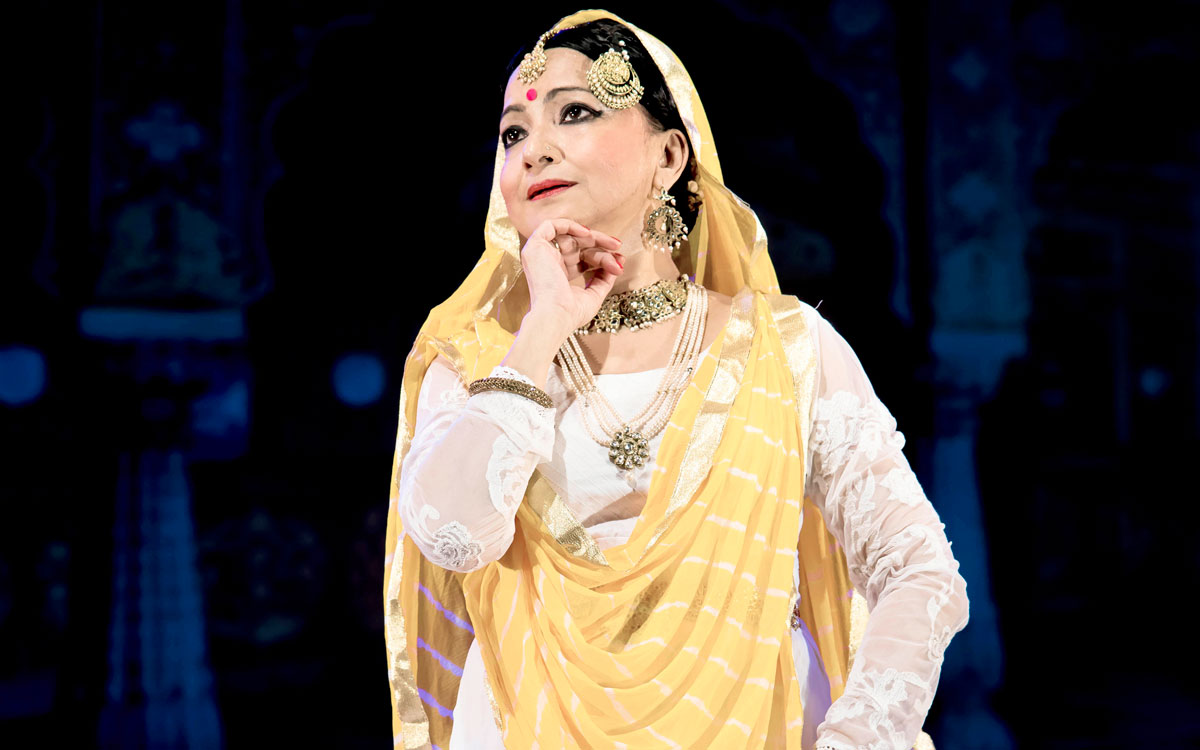Keka Sinha “Wish To Dance Till My Last Breath”
Acknowledged among the foremost Kathak exponents in the city, Keka Sinha is known for her involvement, passion and devotion for the Kathak dance style. In an exclusive interview with VIJAY SHANKER, Keka reveals her experience as a performer, teacher, and choreographer, spanning for more than four decades
 How did you start dancing?
How did you start dancing?
I started Dancing at the age of 4. No I’m not from a musical family and heard that my father was punished in his college days because of listening to music on gramophone at his neighbour’s place. In those days in middle class families it was believed that reading novels or listening to music would hamper one’s studies. My father was very fond of Music and any kind of Art in general, so what he could not do he wanted his daughters to pursue. My father was in military service and had a transferrable job. We were in Bareilly when one day he brought a harmonium and a pair of Tabla and appointed a teacher to come and teach music and dance to two of my elder sisters. I used to stand behind and try to do the steps when Masterji told my father that she has dance in her I’ll teach her too. I still use that pair of Tabla and harmonium for my Riyaz as I feel they are my father’s blessings. It was because of him that we sisters were introduced to dance and music at such an early age.
How did you select Kathak?
After Bareily my father was transferred to Kolkata, a culturally awakened city where in every family children learnt some form of Fine Art. My father gave us the liberty to choose whatever we wanted to learn and whereas my other sisters chose guitar, vocal music & sitar, I chose Dance. At that age I wasn’t very much aware of different forms of classical dance and since I had learnt Kathak earlier I continued with it.
What was your family reaction?
My family were very supportive. Ours was a big family and in those days parents would not go and sit in the class or interfere or worried about what the child was learning but they were very encouraging. I remember taking my mother’s best sarees and jewellery to wear at the functions and they would come to watch. I used to enjoy my creative dance classes more as I felt Kathak classes were too much of hardworking was a pet of my teachers and I remember my Kathak Guru wanted to send me for an All India Competition in Allahabad saying that he was sure I would be able to qualify, but that my parents did not allow. My first solo performance was at age 7 at Ashutosh College Auditorium among stalwarts in the field of music.
 Which is your most memorable performance?
Which is your most memorable performance?
Every performance’s of mine has been memorable but I was pleasantly surprised when in 2001 I was invited to perform for the Elephanta festival, organised by Maharashtra Tourism Development Corporation.
I still remember the stage, the artists, what costume I wore, what I danced and the applause from the audience of my first solo performance at the age of 7, the Iast conference that I performed in Tansen Sangeet Sammelan, Kolkata. My first performance in Mumbai as a professional dancer at Little Theatre, NCPA. The first programme that I organised in Mumbai at The House of Soviet Culture where both my kid daughters participated and guests of honour were Roshan Kumariji and ShobhaGurtuji.My 1st performance abroad (2 ½ hrs) at BharatiyaVidyaBhavan, London. My 1st professional choreography (script & music) ‘Bimbabati’ based on Tagore’s poem, 1stLec-dem for foreign delegates at Taj Hotel under ‘Vaitalik’.
How was your experience with your Gurus?
Both my Gurus Bandana Senji and Reba Vidyarthiji were direct disciples of Pt ShambhuMaharajji. I shared the wonderful relation with both my Gurus. I don’t remember them scolding me or losing their temper they were very patient. Actually, the bond was more than just teacher and student. It was more like family members and there were many things apart from the dance that we learned by observing them, like how they spoke to others, their behaviour with the parents of students, during performances.
When did you decide to become a professional dancer?
Although my father encouraged us to learn dance and music it was believed during those days that only out of need a girl would go out to earn money. It was for any kind of job leave alone dance. Professional dancers were looked down upon, girls from good families would not do that. Since I got married at the early age of nineteen didn’t get the opportunity to actually think of myself as a professional dancer but I always wanted to continue the dance. For six years after marriage I did not dance and then my husband seeing me feeling miserable without dance encouraged me to start again and from then onwards there was no looking back. It was only after coming to Mumbai I realised that being a professional is honourable and people take you more seriously as a dancer than if you pursue it as a hobby.
 Which role is more important…daughter, wife, mother, teacher, and choreographer?
Which role is more important…daughter, wife, mother, teacher, and choreographer?
Every role is important as we cannot sacrifice one for the other. The most difficult part is to strike a balance between the respective responsibilities. Earlier women who opted for the career in Performing Arts mostly chose to remain single as the life of an artiste they felt would not be accepted in our society.
What is your towards Bollywood dance?
I try to respect every form of dancing, as the all the dances has its own beauty and charm and it is not fair to say that a particular dance is inferior or superior, they are like different flowers in the garden, each has its own color and fragrance.. Nothing is easy if one wants to master any form of Art. It involves hard work and commitment. As long as it is not vulgar or in bad taste any dance form is welcome. But if children are introduced to the classical or creative style of dance it makes a strong foundation then one can choose.
Which is the thing that disturbs and irritates you in your life?
When people are not respective of the career as a dancer, do not understand how much it takes to become a performing artiste as well as a Guru, when we are questioned why take up this career when it’s not that lucrative, sometimes not even considered as a career. When artists are expected to perform free whereas people don’t mind spending on other paraphernalia.


